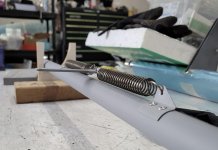Happy Holidays Everyone!
Our 14A will have Garmin servos for pitch and roll. I have not considered any other “fly by wire” gear as in aileron or yaw trim.
The fuselage is complete with pitch servo and pushrods installed, the wings are just about ready for the bottom skins. We’re reconsidering the aileron trim installation.
Curious if such trim is a “must have” or a nice extra.
Thanks-
Pete
Our 14A will have Garmin servos for pitch and roll. I have not considered any other “fly by wire” gear as in aileron or yaw trim.
The fuselage is complete with pitch servo and pushrods installed, the wings are just about ready for the bottom skins. We’re reconsidering the aileron trim installation.
Curious if such trim is a “must have” or a nice extra.
Thanks-
Pete





